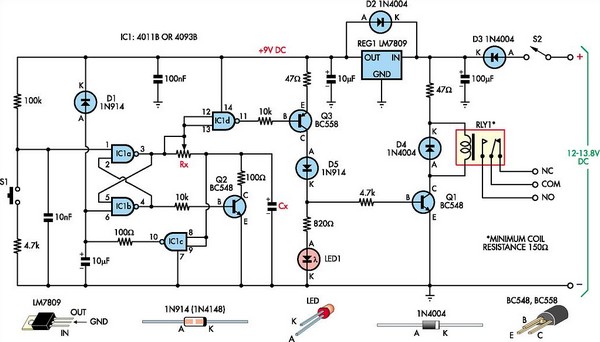Home » Circuits
Multipurpose Flip-Flop Timer
This particular timing circuit can be used to time one-shot events from a few seconds to a few hours. And in standby mode (ie, with RLY1 and LED1 off), its power consumption is very low. The heart of this circuit is a low-cost CMOS 4011 quad NAND gate, with IC1a & IC1b configured as a standard Set/Reset flip-flop. Briefly pressing switch S1 to start the timing sequence pulls pin 1 of IC1a low and, as a result, pin 3 switches high. Two things happen while pin 3 is high: capacitor Cx begins charging via potentiometer Rx; and (2) pin 11 of IC1d will be low, which means that transistors Q3 and Q1 are both on.As a result, both LED 1 and relay RLY1 are also on. RLY1 and LED 1 remain on until Cx has been charged up to about 70% of Vcc (ie, the supply rail). At this point, pins 8 & 9 of IC1c are pulled high and so its pin 10 output goes low and resets the flip-flop by applying a low to pin 6 of IC1b. This causes pin 3 of IC1a to go low and so LED1 and RLY1 switch off and the timing period ends. At the same time, pin 4 of the flip-flop goes high and this turns on transistor Q2 while ever the flip-flop is held reset. This ensures that Cx is discharged, so that the circuit is ready the next time S1 is pressed.
Circuit diagram:
Diode D1 and its associated 10µF capacitor reset the flip-flop when power is first applied, so that LED1 and RLY1 remain off until S1 is pressed. D4 is included to protect Q1 against the back-EMF that's generated when the relay switches off. Choosing appropriate values for Cx & Rx for a given time delay is straightforward. The formula is T = 1.24 x Rx x Cx, where T is the delay time in seconds. As an example, let's assume that we require a time delay of 10s using a value of 100µF for Cx. Now we just need to calculate the value of Rx as follows:
- Rx = 10s/(1.24 x Cx) = 80,645O
Author: Trent Jackson - Copyright: Silicon Chip Electronics

